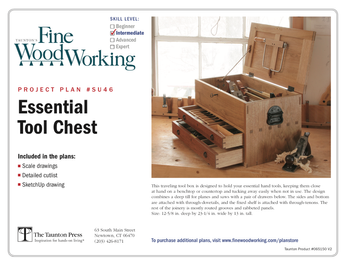Anyone know if Acacia wood is safe to use for food use? Rolling pins, spoons, bowls.
Discussion Forum
Get It All!
UNLIMITED Membership is like taking a master class in woodworking for less than $10 a month.
Start Your Free TrialDiscussion Forum
Digital Plans Library
Member exclusive! – Plans for everyone – from beginners to experts – right at your fingertips.
Highlights
-
Shape Your Skills
when you sign up for our emails
This site is protected by reCAPTCHA and the Google Privacy Policy and Terms of Service apply. -
 Shop Talk Live Podcast
Shop Talk Live Podcast -
 Our favorite articles and videos
Our favorite articles and videos -
E-Learning Courses from Fine Woodworking
-
-
 Fine Woodworking New England Event
Fine Woodworking New England Event












Replies
Tom, there are over a thousand species of Acacia out there...about 15 native to North America...so it depends somewhat on which one you're using. They belong to the legume family and the seeds of some of them are used for food and animal fodder. They aren't notorious for being exceptionally toxic, but some have moderately coarse texture, which isn't a good feature in food related items. Functionally, the best wood for this purpose is hard maple.
Jon, Thanks for the info. I have a big chunk of knarled Acacia trunk (Australian) that i'm going to use to turn some things, thinking it could be interesting grain and color. I know maple is the better choice and have used it often, but would like to see what i get with the Acacia. I can't imagine they are so toxic that it would effect food if used as a rolling pin or a wooden spoon? Thanks again, Tom
Tom, cutting boards and rolling pins are one thing, stirring spoons and food storage containers are another. Even if a wood has some toxic properties, casual contact isn't always that dangerous...but heat, moisture and time (prolonged exposure to food or drink) all increase the danger of leaching out enough of the toxin to cause a problem. If a wood contains a toxin, about the worst thing you could do is make a spoon out of it and leave the spoon in a pot of hot stew for a few hours. Also, making a wine cask out of a toxic wood is another sure ticket to paradise.
I love to experiment with unfamiliar woods, but I never recommend anything but maple for food related items. I'm sure I'm excessively cautious on this topic and many other woods are safe enough for the purpose, but this is the sort of mistake you only make once...and I try to avoid those kinds of risks.
Jon, do you know any reson that sweet gum wouldn't be as suitable for spoons? The local spoon factory was shipped to Korea some years back. They turned gum logs on a veneer lathe and stamped out little ice cream spoons. I've used gum for kitchen stirring utensels.
BJGardening, cooking and woodworking in Southern Maryland
Bee Jay, sweetgum should be one of the safer species for food related items. It produces a balsam (resin) called storax that has been used in chewing gum and medicines. Also, it's a fine textured wood with good turning properties. It does contain some acids like those found in walnut that have some pharmacological properties, mostly in the bark and foliage, but it's not known for being a particularly toxic species. It's a member of the witch-hazel family, which has played a role in folk medicines, perfumes and other concoctions for centuries.
If your Aussie Acacia is anything like it's Hawaiian cousin, Kao I'm sure it will be georgeous.
John O'Connell - JKO Handcrafted Woodworking
Life is tough. It's tougher if you're stupid - John Wayne
This forum post is now archived. Commenting has been disabled